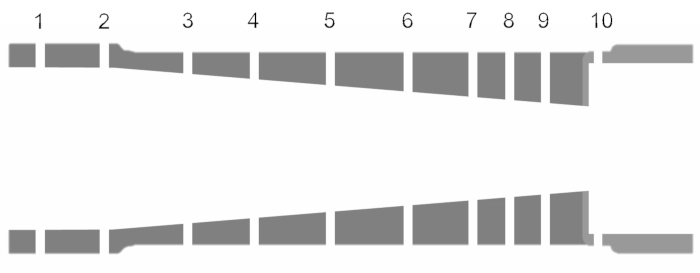Analisi degli ugelli: variazioni del numero di Mach e della pressione lungo un ugello convergente e un ugello convergente-divergente
Panoramica
Fonte: Shreyas Narsipur, Ingegneria meccanica e aerospaziale, North Carolina State University, Raleigh, NC
Un ugello è un dispositivo comunemente usato per accelerare o decelerare il flusso in virtù della sua sezione trasversale variabile. Gli ugelli sono ampiamente utilizzati nei sistemi di propulsione aerospaziale. Nei razzi, il propellente che viene espulso dalla camera viene accelerato attraverso un ugello per creare una forza di reazione che spinge il sistema. Nei motori a reazione, un ugello viene utilizzato per trasformare l'energia da una fonte ad alta pressione in energia cinetica dello scarico per produrre spinta. Il modello isentropico lungo l'ugello è sufficiente per un'analisi di primo ordine in quanto il flusso in un ugello è molto rapido (e quindi adiabatico ad una prima approssimazione) con perdite di attrito molto piccole (perché il flusso è quasi unidimensionale con un gradiente di pressione favorevole, tranne se si formano onde d'urto e gli ugelli sono relativamente brevi).
In questo esperimento, due tipi di ugelli sono montati su un banco di prova dell'ugello e viene creato un flusso di pressione utilizzando una fonte di aria compressa. Gli ugelli vengono eseguiti per diverse impostazioni di contropressione per analizzare il flusso interno negli ugelli in condizioni di flusso variabili, identificare i vari regimi di flusso e confrontare i dati con le previsioni teoriche.
Procedura
In questa dimostrazione è stato utilizzato un banco di prova dell'ugello, che consisteva in una sorgente di aria compressa che incanala l'aria ad alta pressione attraverso gli ugelli da testare, come mostrato nella Figura 5. La pressione di flusso varia da 0 a 120 psi ed è controllata tramite una valvola meccanica. Mentre le pressioni vengono misurate utilizzando un sensore esterno, le portate di massa nell'ugello vengono misurate da una coppia di rotametri posizionati proprio prima dello sc
Risultati
Nell'analisi sono state utilizzate le seguenti costanti: calore specifico dell'aria secca, γ: 1,4; area dell'ugello di riferimento, Ai = 0,0491 in2, e pressione atmosferica standard, Patm = 14,1 psi. Le figure 8 e 9 mostrano la variazione del rapporto di pressione e del numero di Mach sulla lunghezza dell'ugello (normalizzato in base alla lunghezza totale dell'ugello) per varie impostazioni di retropressione per gli ugelli convergenti e convergenti-divergenti.
Applicazione e Riepilogo
Gli ugelli sono comunemente usati nei sistemi di propulsione di aeromobili e razzi in quanto offrono un metodo semplice ed efficace per accelerare il flusso a distanze limitate. Al fine di progettare ugelli per adattarsi a una determinata applicazione, una comprensione del comportamento del flusso e dei fattori che influenzano tale comportamento per una serie di condizioni di flusso è essenziale per la progettazione di sistemi di propulsione efficienti. In questa dimostrazione, gli ugelli convergenti e convergenti-diver.
Vai a...
Video da questa raccolta:

Now Playing
Analisi degli ugelli: variazioni del numero di Mach e della pressione lungo un ugello convergente e un ugello convergente-divergente
Aeronautical Engineering
37.8K Visualizzazioni

Prestazioni aerodinamiche di un aeromodello: il DC-6B
Aeronautical Engineering
8.2K Visualizzazioni

Caratterizzazione dell'elica: variazioni di passo, diametro e numero di pale sulle prestazioni
Aeronautical Engineering
26.1K Visualizzazioni

Comportamento del profilo alare: distribuzione della pressione su un'ala Clark Y-14
Aeronautical Engineering
21.0K Visualizzazioni

Clark Y-14 Wing Performance: implementazione di dispositivi ad alto sollevamento (flap e lamelle)
Aeronautical Engineering
13.3K Visualizzazioni

Metodo della sfera di turbolenza: valutazione della qualità del flusso nella galleria del vento
Aeronautical Engineering
8.6K Visualizzazioni

Flusso cilindrico incrociato: misurazione della distribuzione della pressione e stima dei coefficienti di resistenza
Aeronautical Engineering
16.1K Visualizzazioni

Schlieren Imaging: una tecnica per visualizzare le caratteristiche del flusso supersonico
Aeronautical Engineering
11.3K Visualizzazioni

Visualizzazione del flusso in un tunnel d'acqua: osservazione del vortice di estremità su un'ala delta
Aeronautical Engineering
8.0K Visualizzazioni

Visualizzazione del flusso di colorante superficiale: un metodo qualitativo per osservare le linee di flusso nel flusso supersonico
Aeronautical Engineering
4.9K Visualizzazioni

Tubo Pitot-statico: un dispositivo per misurare la velocità del flusso d'aria
Aeronautical Engineering
48.6K Visualizzazioni

Anemometria a temperatura costante: uno strumento per studiare il flusso turbolento dello strato limite
Aeronautical Engineering
7.2K Visualizzazioni

Trasduttore di pressione: calibrazione mediante tubo statico Pitot
Aeronautical Engineering
8.5K Visualizzazioni

Controllo di volo in tempo reale: calibrazione del sensore incorporato e acquisizione dati
Aeronautical Engineering
10.1K Visualizzazioni

Aerodinamica multirotore: caratterizzazione della spinta su un esacottero
Aeronautical Engineering
9.1K Visualizzazioni


